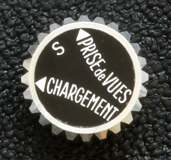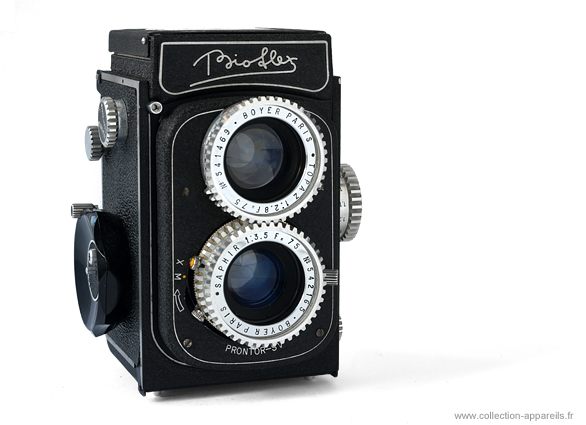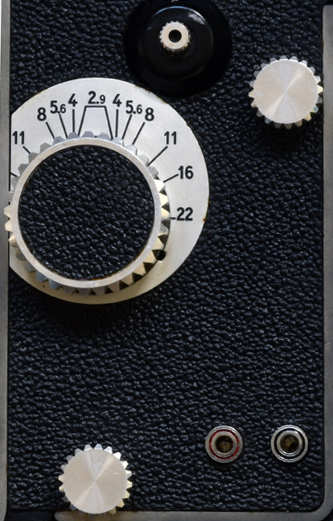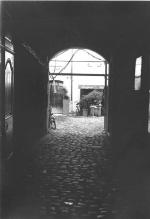|
Alsaphot Bioflex |
Manufactured or assembled in France from 1954 to (Circa) 1959.
Index of rarity in France: Infrequent (among non-specialized garage sales)
Inventory number: 13986
See the complete technical specifications
Chronology of cameras Alsaphot
The Paris-based company Prélux, the creator of Bioflex, made contact with the Alsaphot factory in Angers in 1954 to handle its assembly. This continued until 1962 (source: Les Fondamentaux n°74 of the Club Niepce Lumière on Henri Lapart). It's a 6 x 6 twin-lens reflex camera that accepts both 120 and 620 films. The shutter is a Prontor-SV.
The aperture and shutter speed values are visible through the toothed rings on the lens. Film advance is automatic, controlled by a large button with an extendable crank. The controls appear to be designed for use with thick gloves, and the handling is not comfortable.
The initial production used SAGEM lenses (Guépar and Jaguar with the same serial numbers). The Jaguar 2.9 featured a 4-lens optical formula.
On the earliest models, the lever (more like a button) used to manipulate the toothed ring for shutter speeds was very small. It was later extended for better ergonomics. Interestingly, even though this part of the production had an automated film loading system (with three positions) and a frame counter, there was an inactive window. This window disappeared later in the production run.
The second part of the production used BOYER lenses (Topaz and Saphir with different numbering). The Saphir 3.5 featured a 3-lens optical formula. The exact date of the switch is not known, but the 1959 France Photo catalog only listed models with Jaguar lenses. The inactive window reappeared. The frame counter and its mechanism remained, as did the automatic film loading. They likely disappeared towards the end of production, probably to reduce costs. It's worth noting that the markings for the automated loading system remained despite the mechanism being removed. It took the latest models to restore some consistency.
The Bioflex cameras did not enjoy significant commercial success, and the selling price gradually declined. On the film advance and shutter cocking wheel, the device for double exposure capability is removed. On the rotating bakelite knob, the mechanism (a small metal axis placed in its center) that allows unlocking for the deployment of the small crank disappears, along with the crank itself. Some units only incorporate the removal of the mechanical counter, while others, presumably the later ones, combine all the regressions.
The Bioflex cameras were not numbered. The main identifier in this production is the lens numbers, but for the Boyer lenses, the chronological order of lens numbering does not always correspond to the small changes encountered.
(* According to catalogs, their presence was confirmed until 1960.)
This particular unit is a transitional model with anomalies. The depth of field designation on the focus button is for a 2.9 lens, not a 3.5 lens, even though the aperture adjustment ring, which has not been modified, still bears the engraving for 2.9 instead of 3.5 for the widest aperture. However, aperture adjustment is not possible for 2.9 as it locks before reaching that setting. It should align with 3.5, which is not marked.
Similar to the more recent first-generation Bioflex models:
- There is a non-actinic window.
- On the left side, there is a three-position dial for "Loading - S - Shooting"
- There is a flash synchronization socket with two pins.
Concerning the three-position device, here's what the instruction manual states:
 |
It behaves differently based on whether the camera is already loaded or not. The "S" position, standing for "safety," locks the shutter release. If the camera is empty and you want to set the selector to "Chargement" (loading), you need to first set the locking button to the shooting position and then turn the frame counter knob clockwise until it locks (you should hear a click). This step is necessary to be able to turn the locking button to the loading position after loading. Prior to this, ensure that the frame counter is set to position 1. |
|
Once the loading operations are completed, you need to turn the locking button to the shooting position. This action will unlock the shutter, engage the counter, and release the lock on the first frame. The camera is now ready to take the first shot! For unloading, after taking all 12 shots, you need to operate the advance button, which sets the frame counter to frame number 1. Place the locking button in the loading position to proceed with winding the film and extracting it. The camera is automatically ready for a new loading cycle. |
|


Interesting links or bibliography :
Add a link or element of bibliography, a picture taken with this camera, a picture of box or an ads about this camera
Your photos taken with the same camera:
Cameras from Ebay France (Alsaphot) (Uploaded each 3 hours)
 APPAREIL PHOTO ALSAPHOT "DAUPHIN" MADE IN FRANCE 25,00 euros Finira le 10-05-2024 à 13:44:27 |








